Class 10 FRANK Solutions Physics Chapter 1.5 - Different Forms, Conservation and Transformation of Energy
Revise from accurate Frank Solutions for ICSE Class 10 Physics Chapter 1.5 Different Forms, Conservation and Transformation of Energy at TopperLearning. Learn the SI unit of energy. Understand the parameters that can change kinetic energy. Also, revise the concept of potential energy with our well-prepared Physics solutions.
Get clarity on the basic chapter concepts with our ICSE Class 10 Physics video lessons. Also, practise the MCQs from this chapter with our Physics mock tests. For more help, check the other Physics study materials such as concept videos, revision notes etc. on our study portal.
53
54
Different Forms, Conservation and Transformation of Energy Exercise 53
Solution 1
The energy possessed by a body by virtue of its motion is called kinetic energy.
Solution 2
Examples of kinetic energy:
(i) Air in motion has kinetic energy.
(ii) A swinging pendulum
(i) Air in motion has kinetic energy.
(ii) A swinging pendulum
Solution 3
SI unit of energy is 'joule'.
Solution 4
Work
Solution 5
'Energy' is the body's ability to do work.
Solution 6
Energy is a scalar quantity.
Solution 7
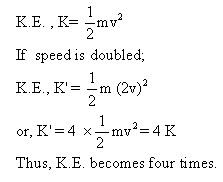
Solution 8
Kinetic energy of a body depends upon:
(i) Mass of the body
(ii) Speed of the body
(i) Mass of the body
(ii) Speed of the body
Solution 9
Yes, if the body is not in motion; it has zero kinetic energy
Solution 10
A moving bullet possesses kinetic energy
Solution 11
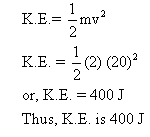
Solution 12
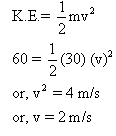
Solution 13
Flowing water possesses kinetic energy.
Solution 14
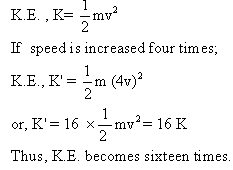
Solution 15
The car should be moving faster because the mass of the car is less than that of the bus.
Solution 16
Its kinetic energy changes with the change in velocity.
Velocity becomes zero at the highest point.
Velocity becomes zero at the highest point.
Solution 17
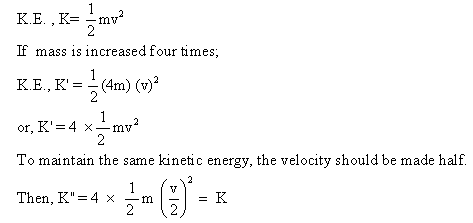
Solution 18

Solution 19
The parameters that can change the kinetic energy are:
(i) Mass
(ii) Speed
(i) Mass
(ii) Speed
Solution 20
A ball at lying at rest on the floor possesses zero kinetic energy.
Solution 21
The energy possessed by a body by virtue of its position, shape or change of configuration is called potential energy.
Solution 22
Potential energy of a body depends upon:
(i) Mass of the body
(ii) Acceleration due to gravity
(iii) Height of the body
(i) Mass of the body
(ii) Acceleration due to gravity
(iii) Height of the body
Solution 23
Solution 24
Examples of potential energy:
(i) Water stored at a height in a reservoir.
(ii) A stretched spring.
(i) Water stored at a height in a reservoir.
(ii) A stretched spring.
Solution 25
P.E of a body lying on a floor is zero.
Solution 26
The energy spent by the heart in pumping blood through the body is 1 J per beat.
Solution 27
Potential energy
Solution 28
The work done in winding a clock spring is stored as P.E. in the spring. This P.E. is then used to run the hands of the clock.
Solution 29
P.E. of a body of mass M and at a height H above the earth's surface is:
P.E. = MgH ; here, g = acceleration due to gravity.
P.E. = MgH ; here, g = acceleration due to gravity.
Solution 30
P.E. is a scalar quantity.
Solution 31
(i) Potential energy
(ii) Heat energy
(iii) Potential energy
(ii) Heat energy
(iii) Potential energy
Solution 32
(i) At the height H because the height is maximum.
(ii) At the ground level because the velocity is maximum.
(iii) At half distance of the total path i.e. at height H/2, the P.E. is equal to the K.E.
(ii) At the ground level because the velocity is maximum.
(iii) At half distance of the total path i.e. at height H/2, the P.E. is equal to the K.E.
Solution 33
(a) As the height above the ground increases, the potential energy also increases.
(b) At the highest point, the height of the cricket ball is maximum and hence the potential energy is also maximum.
(b) At the highest point, the height of the cricket ball is maximum and hence the potential energy is also maximum.
Different Forms, Conservation and Transformation of Energy Exercise 54
Solution 34
P.E. is the energy possessed by a body by virtue of its position, shape or configuration but K.E. is the energy possessed by a body by virtue of its velocity or motion.
E.g. A ball kept on a cliff possesses P.E. but as soon as it is kicked it possesses K.E.
E.g. A ball kept on a cliff possesses P.E. but as soon as it is kicked it possesses K.E.
Solution 35
Whenever one form of energy dissipates or disappears, another form of equivalent amount of energy is produced; this is referred to as transformation of energy.
E.g. when a particular switch is pressed electric lamps light up owing to the heat produced in the filament. This is the transformation of electrical energy to heat and light energy.
E.g. when a particular switch is pressed electric lamps light up owing to the heat produced in the filament. This is the transformation of electrical energy to heat and light energy.
Solution 36
No, total energy of a body does not remain constant but the total energy of a closed system remains constant e.g. universe.
Solution 37
Energy is a scalar quantity.
Solution 38
No, we cannot destroy energy associated with a body.
Solution 39
Energy is the capacity or ability of a body to do work or energy is stored work.
Solution 40
The law of conservation of energy states that energy cannot be created or destroyed; the sum total of energy in a closed system remains unchanged. Energy only changes from one form to another.
Solution 41
A dry cell converts chemical energy into electrical energy.
Solution 42
A D.C. motor converts electrical energy into mechanical energy.
Solution 43
A dynamo converts mechanical energy into electrical energy.
Solution 44
Four different forms of energy:
(i) Solar energy
(ii) Mechanical energy
(iii) Wind energy
(iv) Nuclear energy
(i) Solar energy
(ii) Mechanical energy
(iii) Wind energy
(iv) Nuclear energy
Solution 45
At a thermal power station, nuclear energy is converted into electrical energy.
Solution 46
(i) Electrical energy to sound energy
(ii) Mechanical energy into heat energy.
(iii) Potential energy into kinetic energy and vice-versa.
(iv) Chemical energy obtained from food is converted into mechanical energy and heat energy in muscles.
(v) A dynamo converts mechanical energy into electrical energy.
(ii) Mechanical energy into heat energy.
(iii) Potential energy into kinetic energy and vice-versa.
(iv) Chemical energy obtained from food is converted into mechanical energy and heat energy in muscles.
(v) A dynamo converts mechanical energy into electrical energy.
Solution 47
The rate of doing work is called power.
Solution 48
'Watt' is the SI unit of power.
Solution 49
Horse power is the unit of power. The horsepower used for electrical machines is defined as exactly 746 watt.
Classically, a horse exerting 1 H.P. can raise 330 pounds of coal 100 feet in a minutes, or 33 pounds of coal 1,000 feet in one minute, or, 1,000 pounds 33 feet in one minute.
Classically, a horse exerting 1 H.P. can raise 330 pounds of coal 100 feet in a minutes, or 33 pounds of coal 1,000 feet in one minute, or, 1,000 pounds 33 feet in one minute.
Solution 50
If 1 joule of work is done in 1 second, the power is said to be 1 watt.
1 H.P. = 746 watt
1 H.P. = 746 watt
Solution 51

Solution 52
Power is the physical quantity associated with the 'rate of doing work'.
Solution 53

Solution 54
Practical or commercial unit of power is kilowatt-hour.
Solution 55
When we wind a watch, the configuration of its spring is changed. The energy stored in the spring is obviously potential in nature (elastic potential to be more accurate).
Solution 56
This heat energy comes from the mechanical energy.
Solution 57
When we rub our hands, mechanical energy is converted into heat energy.
Solution 58
When the head of a nail is struck with a hammer, the mechanical energy of the hammer pushes the nail into the plank of wood and in this process a part of energy is converted into heat energy.
Solution 59

Solution 60
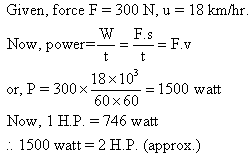
Solution 61
Solution 62
Solution 63
Examples of energy degradation: -
- When we run a vehicle, only a part of energy obtained from its fuel is used up in running the vehicle, major part of it is wasted in heating the moving parts of machine, in doing work against friction between the ground and its tyres and in the form of sound.
- In electric fan, some amount of electrical energy used to run motor (converting electrical energy to mechanical energy) is lost as heat energy and hence does not do any productive work in this case.



